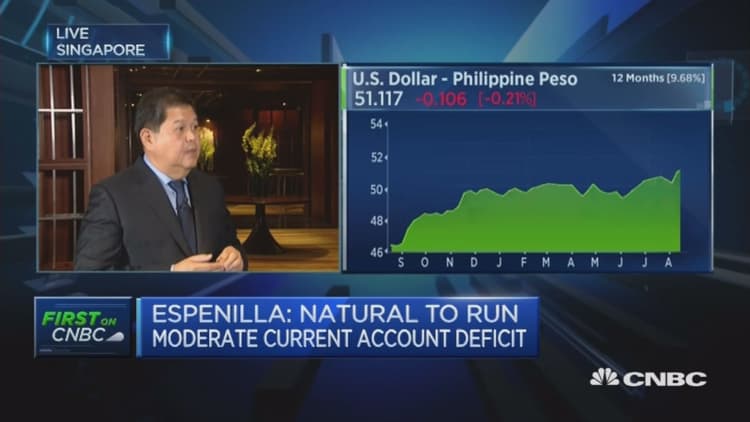
The Philippines' peso has tumbled to a fresh 11-year low, but the country's policymakers said that heralded good tidings.
Nestor Espenilla, governor of the country's central bank, Bangko Sentral ng Pilipinas, or BSP, said he wasn't worried about either the deficit or the currency's drop — or even his expectation that the may fall further.
The Philippine currency has been the worst performing in Asia this year, with the U.S. dollar rising around 3.7 percent against the peso. In contrast, the peso's peers have generally gained against the greenback.
The dollar was fetching 51.159 pesos at 10:27 a.m. HK/SIN on Tuesday. Analysts have blamed the weakness on the country's current account deficit, which is when the value of a country's total imports exceeds its total exports. The difference between the two figures often must be financed by debt.
"The Philippines is an emerging market that's growing quite fast. It's natural for such a market to have a current account deficit," Espenilla told CNBC's "Squawk Box" on Tuesday. "What's important is the quality of that deficit. If you look underneath the numbers, it's actually capital goods imports that are behind it. And this is going to improve productive capacity of the economy further."
He added that the current account deficit wasn't going to rise to more than 1 percent of gross domestic product.
"Today, the Philippines has good market access, low external debt, and therefore, this current account deficit is something the economy can readily finance," Espenilla said on the sidelines of a Philippine economic briefing in Singapore.
The central banker also said he wasn't overly concerned that the peso's fall might stoke price increases in the country, citing official forecasts that inflation would remain just above its 3 percent target ahead.
"Since we have shown credibility in our inflation targeting, the pass-through effects on inflation of exchange rate depreciation have become very markedly low," he said.
Analysts were somewhat more concerned about the currency.
In a note on Monday, economists at bank ANZ noted that remittances in the fourth quarter from overseas Philippine workers and funds flowing into the country's growing outsourcing industry ceased to offset the Philippines' trade deficit.
Remittances have risen this year, up 4.5 percent between January and May from the year-earlier period to $11.35 billion, according to data from the central bank.
But ANZ noted that imports have surged, particularly for capital goods to be used in the construction industry.
While the country's efforts to build its lagging infrastructure were likely a beneficiary of those imports, ANZ said it was concerned about expanding credit to the real estate sector, citing "spectacular" property price rises.

Indeed, ANZ said a mix of the current account deficit, credit growth, low inflation and a central bank that isn't changing interest rates would have pushed the peso down even further, but the BSP appeared to be intervening in the market, with international reserves declining.
The archipelago's overall economy, however, appeared to still be humming along: Capital Economics estimated that the economy grew around 6.5 percent year-over-year in the second quarter. Those data are due later this week.
In the first quarter, the Philippine economy grew 6.4 percent year-on-year.
Benjamin Diokno, the Philippines' secretary of budget and management, said he expected economic growth would come in around 7 percent for 2017, which would be the midpoint of the official 6.5 to 7.5 percent official range.
He also talked up the positives of the peso's fall.
"Luckily, a depreciation favors our overseas Filipino workers and their families, maybe about half of the population benefit from a weak peso. And our exports also will benefit," Diokno told CNBC's on Tuesday.
Diokno also highlighted the Duterte administration's policy priorities.
"Our major focus in the years to come, not only this year, is build, build, build," he said. "We have to buy capital goods and invest. And it's natural for a country that is growing and investing to have a short-term current account deficit."
Diokno noted that the country had sufficient dollars in reserve to service its debt, with a total of around $50 billion in inflows every year from remittances and the outsourcing industry.


